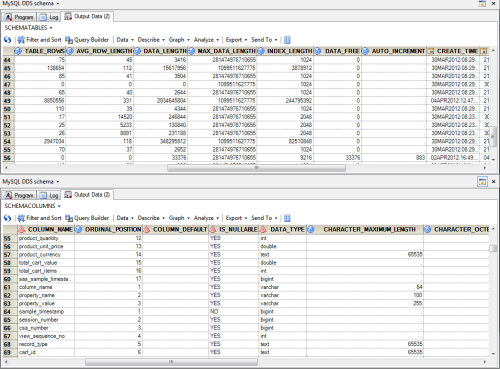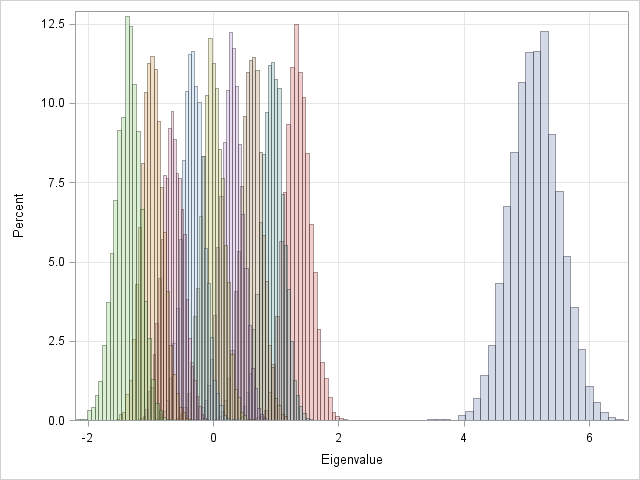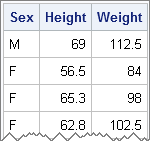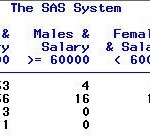Back in 2009, I announced that SAS was developing a version of its business analytics platform for use on the Nintendo Wii. I think I gave our legal department a heart attack with this news, until they realized that I had posted it on April 1. At SAS Global Forum
English

If you're looking for some good stuff to read ... I mean great stuff for SAS users, I've had this list brewing in my head for a few weeks now. (The reason that I ask is because in the US, this weekend will be a three-day holiday to commemorate Memorial Day. So, many families will
In a previous blog, I showed how to use SAS/IML subscript reduction operators to compute the location of the maximum values for each row of a matrix. The subscript reduction operators are useful for computing simple statistics for each row (or column) of a numerical matrix. If x is a

On the SAS-L mailing list, a participant posed this question (paraphrased): How can I tell which date format my Windows session is using: European format (with day first) versus USA format (with month first)? I'm reading in output from a Windows file listing, and need to know how to interpret

In August 2011, we expanded the scope of the SAS Global Forum blog and rebranded it as the SAS Users Group blog. Our goal was to create one vibrant and dynamic spot for content related to SAS users groups and SAS user presentations. The result has been terrific! Many new

The other day I encountered an article in the SAS Knowledge Base that shows how to write a macro that "returns the variable name that contains the maximum or minimum value across an observation." Some people might say that the macro is "clever." I say it is complicated. This is
At SAS Global Forum, and again at PharmaSUG, we had the pleasure of attending many papers and presentations on various topics that included graphs in the power point decks or in the papers. More often than not, the graphs exist along other text, and occupy a smaller part of the screen

It's Friday, and on SAS Voices they are posting fun stuff about dogs who work at SAS. I'm posting about PROC SQL and MySQL. You tell me - which of us knows how to ring in the weekend with style? I've been working with MySQL data sources lately, and SAS/ACCESS

At SAS Global Forum, one of the most difficult areas for me to show to you are the poster presentations. This year, I asked Steve Polilli, a colleague who is great with a Flipcam, to video a few for me. I picked out three that I will use in the

Here is the last video from the last day at SAS Global Forum 2012. This one is great! Make sure you stay in there long enough to watch the outtakes: they are so funny!

PharmaSUG 2012 conference drew to a close today, concluding two and a half days packed with papers, presentations, posters, hands-on demos and super demos by SAS staff. While the weather outside was a bit chilly from time to time, the conference what hopping with many user papers on how to

Annette Harris spends several minutes during this video extolling many of the high-performance virtues of Pete Lund, Information Systems Manager, Looking Glass Analytics. One thing she didn't mention (it was mentioned to me later) is that Pete is a long-time member of SAS-L. Do you know how many other SAS

I've been a fan of statistical simulation and other kinds of computer experimentation for many years. For me, simulation is a good way to understand how the world of statistics works, and to formulate and test conjectures. Last week, while investigating the efficiency of the power method for finding dominant

SAS users, by definition, do not embrace the mysterious. That's one of the main reasons that they use SAS: to demystify some data or process. And so, when you (as a SAS user) have gone to the trouble of designing a process flow in SAS Enterprise Guide, you like to

As a SAS fan, in a number of roles over the past 15+ years (programmer, statistician, data warehouse developer, business analyst, consultant, trainer, partner), I am also the Queensland Users Exploring SAS Technology (QUEST) chairperson, and I feel very privileged to be able to contribute to the wider SAS community

SESUG (Southeast SAS Users Group Conference) is an annual conference held in the Southeast US - typically in September or October. This year, the conference will be held at the Sheraton Imperial Hotel and Convention Center in Durham, North Carolina, October 14-16. According to Peter Eberhardt, SESUG 2012 Academic Chair, the

One of the first skills that a beginning SAS/IML programmer learns is how to read data from a SAS data set into SAS/IML vectors. (Alternatively, you can read data into a matrix). The beginner is sometimes confused about the syntax of the READ statement: do you specify the names of

Part of what captivated me about this paper and poster presentation were the presenters - these guys are high school kids using SAS to do a visual analysis of Internet use by high schoolers. The idea was so compelling that Anna Brown and Inside SAS Global Forum went to talk

The semester is coming to an end and summer break is just around the corner, so why should you be thinking about conferences and grant opportunities? Conferences like SESUG provide a lot of great benefits to students.

What tiny looking operator packs a mighty punch with large datasets? Your queries are big. Your reports span multiple columns. To top it all you have to summarize data in multiple ways. Are you tempted to throw in the towel? Do you feel like saying a firm “Can’t be done”

In a previous post I showed how you can use Windows PowerShell (with the SAS Local Data Provider) to create a SAS data set viewer. This approach doesn't require that you have SAS installed, and allows you to read or export the records within a SAS data set file. In

So, when you go to the game, do you buy a hot dog, a beer and a banner before the first quarter? Do you buy them all from the same vendor? Do you go back during the half? Does the score impact how much money you spend on concessions? All

When I was at SAS Global Forum last week, a SAS user asked my advice regarding a SAS/IML program that he wrote. One step of the program was taking too long to run and he wondered if I could suggest a way to speed it up. The long-running step was

Stanley Fogleman says that SAS can be hard to learn on your own - not because it is a difficult language - but because of the various business requirements. In fact, even college students entering the workforce are often ill-prepared in some ways. That's why Fogleman believes that a SAS mentoring program

With the rapid changes in our education systems regarding new standards, assessments, accountability and evaluation, teachers are rightfully feeling the pressure of being underprepared. The majority of teachers were not trained or certified with these rigorous systems in place. Recognizing that higher education institutions need to play an active role
At the 2012 SAS Global Forum, one of the questions from a user was about showing the original data used for the box plot. While you can use outliers in conjunction with the box features to get a feel for the data, for some situations you may need to see exactly

SAS already has some cool mobile Business Intelligence apps. Now, Scott McQuiggan tells Anna Brown, in this Inside SAS Global Forum interview, that you can view the really cool high-performance analytics reports that you've created on your desktop - right from your mobile device. Check this out!!

In statistical programming, I often test a program by running it on a problem for which I know the correct answer. I often use a single expression to compute the maximum value of the absolute difference between the vectors: maxDiff = max( abs( z-correct ) ); /* largest absolute difference

It is becoming more and more apparent that social media is a gold mine of unstructured data that is just waiting to be analysed so that the nuggets can be extracted. At SAS Global Forum, I was particularly impressed with the diversified use of sentiment analysis and the exploration that

Jenn Sykes (you probably remember her from this great sentiment analysis post last year about American Idol), presented Predicting Electoral Outcomes with SAS® Sentiment Analysis and SAS® Forecast Studio at SAS Global Forum 2012. In addition to predicting elections, Sykes tells Anna Brown from Inside SAS Global Forum, that there is a lot of unstructured data










